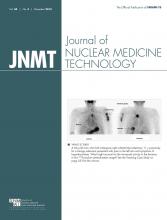Norman E. Bolus, MSPH, MPH, CNMT, FSNMMI-TS
As we approach the end of 2016, I cannot help but grow a little nostalgic when I reflect on our profession. I entered the field in 1988, and I can vividly remember being told that nuclear medicine was on its way to no longer existing. As I learned more about the wondrous things we could do, I wondered why that was the prevailing view. The whole concept of physiologic imaging fascinated me. The ability to see our agents being taken up by organs and then metabolized and eliminated as they are routed to different areas of the body was almost magical. The idea of hammering together raw, homemade systems and imaging technology from the ground up made nuclear medicine even more fantastical to me. Computing power was just then becoming something that was more reliable, and many institutions at that time were using in-house processing programs that smart programmers had developed on their own.
It was also a time of change in our field. In the 3 short years after I began, there was almost a renaissance of new technology, new software programming, and new processing that streamlined and aided our profession. When I started we were still using magnetic tape and floppy disks to store data, had a liquid scintillation γ-camera, and used Polaroid-type film to take pictures off persistence scopes. But by 1991, the field was being revolutionized by new γ-cameras, led by dual-headed models, and tomographic imaging was becoming preferred to planar imaging. On the image display side, color printers gradually took over, followed by daylight film processors, which eventually succumbed to processing workstations and digital-only images.
Now we have imaging with dual techniques such as SPECT/CT, PET/CT, and PET/MR and specialized cardiac imaging cameras that use innovative collimator designs and detectors in series to give us better spatial resolution. These techniques are enhancing image quality while requiring a lower dose and taking less time to achieve results as good as or superior to those obtained previously. All these techniques are once again fascinating and exciting as what we can do gets more sophisticated. Our equipment is streamlined and can practically operate automatically, doing quality control and adjusting to the conformation of our patient. While preparing this editorial, I have just now read of a whole new imaging arena that perhaps is on the horizon—polarized nuclear imaging—combining magnetic resonance with radioactive-drug detection in the body. I have no idea what this entails going forward, but it is once again fascinating to think of the possibilities to which this new imaging technology could lead. It is proof to me that our field is alive and well and will continue to be so. Some may persist in saying that our profession is at its lowest ebb before it finally goes away, just as was said to me 28 years ago, but I say the future for our field looks bright and even scintillating.“The two areas that are changing...are information technology and medical technology. Those are the things that the world will be very different 20 years from now than it is today.”
—Bill Gates
In this edition of JNMT, we have two original continuing education articles, one on the role of 18F-sodium fluoride PET/CT bone scans in the diagnosis of metastatic bone disease from breast and prostate cancer and another on the use of renal scans in the United States. There are several useful imaging articles on a broad range of topics. These include the use of video goggles in children to distract them from moving during a study, the use of heparin when tagging red blood cells, a look at a metabolic signature in gastric adenocarcinoma, and recommendations for nuclear medicine technologists drawn from an analysis of Australian radiation incident registers. There are teaching case studies on topics including metastatic thyroid cancer, Hodgkin lymphoma, mediastinal masses, and splenic implants, as well as a book review. I would like to encourage you to submit teaching case studies, imaging articles, scientific articles, and continuing education articles. If you have an idea for an article, perspective, or commentary to include in JNMT, please let me know. I can best be reached by e-mail (bolusn{at}uab.edu).
For our Facebook discussion this quarter (www.snmmi.org/facebook), I simply ask the question, “Where do you see nuclear medicine technology headed in 2017 and beyond?”








